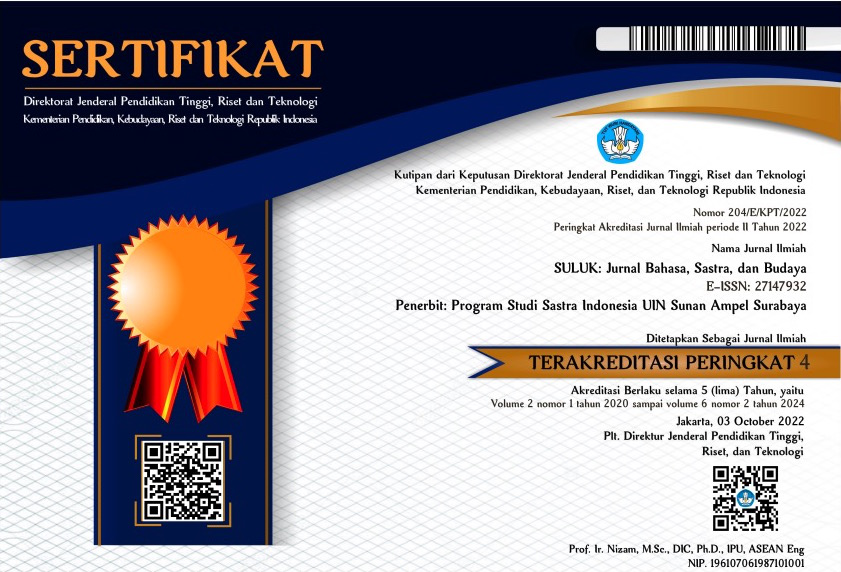Potensi Masjid Syuhada-Kota Yogyakarta Sebagai Bangunan Cagar Budaya
DOI:
https://doi.org/10.15642/suluk.2019.1.2.59-67Keywords:
Cultural Heritage, Special Region of Yogyakarta, Syuhada MosqueAbstract
This study aims to explain the potential of the Syuhada Mosque as a cultural heritage building in Yogyakarta. This study uses a qualitative research method based on a literature review on the History of the Syuhada Mosque by Kumoro (2019), Constitution Number 11 of 2010 concerning Cultural Heritage and Regional Regulations of the Special Province of Yogyakarta, especially Number 6 of 2012 concerning Preservation of Cultural Heritage and Cultural Heritage. The results of this study are (1) The history of the construction of the Mosque of Syuhada in 1950-1952 is closely related to the location and history of the struggle of Indonesia in maintaining independence after the relocation of the capital to Yogyakarta, (2) The Syuhada Mosque has the potential to be a cultural heritage building in Yogyakarta because it is in accordance with the contents of (a) Constitution Number 11 of 2010 concerning Cultural Heritage: Article 1 (number 1), Article 1 (number 3), Article 1 (number 18), and Article 5 and (b) Regional Regulation of the Special Province of Yogyakarta Number 6 of 2012 concerning Preservation of Cultural Heritage and Cultural Heritage: Article 12. Overall, it can be seen that the establishment of the Syuhada Mosque building in Yogyakarta Mayor Decree Number 297 of 2019 related to the Cultural Heritage of the City of Yogyakarta means that the status of the Syuhada Mosque as a list of the Cultural Heritage of the Special Region of Yogyakarta deserves to be upgraded to the Cultural Heritage Building.
Downloads
References
Abieta, Arya dkk. 2011. Pengantar Panduan Konservasi Bangunan Bersejarah Masa Kolonial. Jakarta: Pusat Dokumentasi Arsitektur (PDA).
Anonim. “Masjid Syuhada-Kotabaru Yogyakarta”. https://www.kontraktorkubahmasjid.com/masjid-syuhada-kotabaru-yogyakarta/ 12/8/2018 [23 November 2019].
Kumoro, Panji. 2017. Historisitas Masjid Syuhada. Yogyakarta: Yayasan Masjid Syuhada (YASMA).
Paeni, Mukhlis dkk. 2009. Sejarah Kebudayaan Indonesia: Arsitektur. Jakarta: PT RajaGrafindo Persada.
Pemerintah Indonesia. 2010. Undang-Undang No. 11 Tahun 2010 Yang Mengatur Tentang Cagar Budaya. Jakarta: Sekretariat Negara.
Pemerintah Provinsi Daerah Istimewa Yogyakarta. 2012. Peraturan Daerah Provinsi Daerah Istimewa Yogyakarta Nomor 6 Tahun 2012 tentang Pelestarian Warisan Budaya dan Cagar Budaya. Yogyakarta: Sekretariat Daerah.
Pemerintah Provinsi Daerah Istimewa Yogyakarta. 2011. Keputusan Gubernur Daerah Istimewa Yogyakarta Nomor 186/KEP/2011 tentang Penetapan Kawasan Cagar Budaya. Yogyakarta: Sekretariat Daerah.
Pemerintah Kota Yogyakarta. 2019. Keputusan Walikota Yogyakarta Nomor 297 Tahun 2019 Tentang Daftar Warisan Budaya Daerah Kota Yogyakarta. Yogyakarta: Sekretariat Daerah.
Prasetyo, Himmawan. “Sejarah Masjid Syuhada”. https://kebudayaan.kemdikbud.go.id/bpcbyogyakarta/sejarah-masjid-syuhada/30 /1/ 2015/ [23 November 2019].
Suratmin. 1996. Mengenal Selintas Masjid Syuhada Yogyakarta. Yogyakarta: Departemen Pendidikan dan Kebudayaan.
Downloads
Published
How to Cite
Issue
Section
License
Copyright (c) 2019 Laksmi Eko Safitri

This work is licensed under a Creative Commons Attribution-ShareAlike 4.0 International License.
- Authors retain copyright and grant the journal right of first publication with the work simultaneously licensed under a Creative Commons Attribution ShareAlike License that allows others to share the work with an acknowledgment of the work's authorship and initial publication in this journal.
- Authors are able to enter into separate, additional contractual arrangements for the non-exclusive distribution of the journal's published version of the work (e.g., post it to an institutional repository or publish it in a book), with an acknowledgment of its initial publication in this journal.
- Authors are permitted and encouraged to post their work online (e.g., in institutional repositories, pre-print sites, or on their website) prior to and during the submission process, as it can lead to productive exchanges, as well as earlier and greater dissemination of published work.








